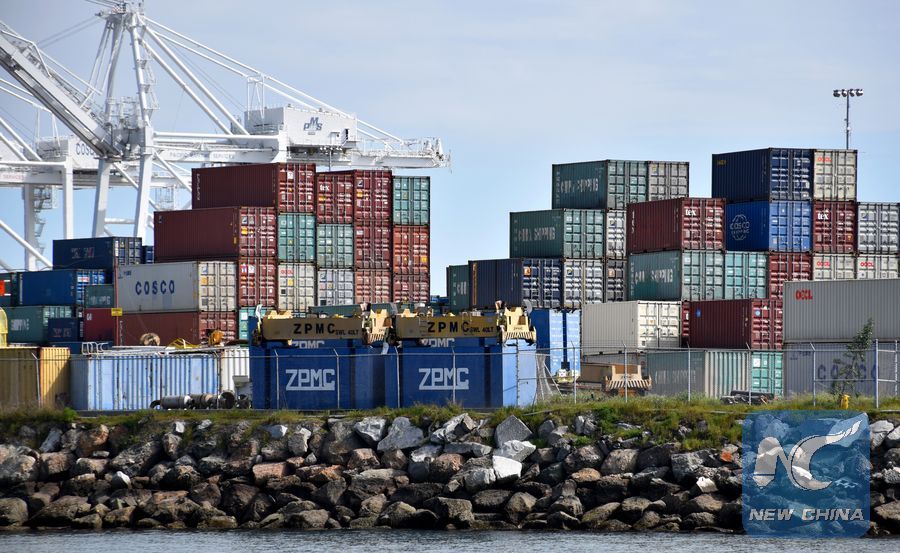
Containers of China COSCO Shipping Corporation Limited are seen at the Port of Long Beach, Los Angeles County, the United States, on Feb. 27, 2019. (Xinhua/Li Ying)
by Xinhua writer Huang Heng
LOS ANGELES, June 21 (Xinhua) -- The uncertainty of China-U.S. trade disputes, which could be prolonged if the White House imposed new tariffs on goods imported from China as threatened, will hit hard the California twin ports of Los Angeles and Long Beach, America's gateway for trans-Pacific trade.
These two ports handle about 40 percent of U.S. containerized imports and 30 percent of U.S. containerized exports, said the Port of Los Angeles in a comments letter to the United States Trade Representative (USTR), who is holding a series of public hearing for the proposed tariffs this week.
The letter stressed that this cargo generates over 310 billion U.S. dollars annually, supports roughly 3 million jobs across the country, and reaches 435 Congressional districts.
Since the twin San Pedro Bay ports account for nearly half of all seaborne trade between the United States and China, they said, the imposed and proposed tariffs against China, a typical one-sided tool for Washington to serve its own interests in dealing with trade disputes with other economies, had hit their business directly.
"China is our largest partner, accounting for 68 percent of containerized imports and 28 percent of containerized exports. So a prolonged trade dispute with our largest trading partner would affect cargo throughput," Mario Cordero, executive director of the Port of Long Beach, told Xinhua in an email interview Wednesday.
According to the latest monthly cargo data issued last week, the two ports reported that their overall volume in May was down 6.6 percent year on year, among which exports were down significantly for the seventh month in a row and the Long Beach Port's imports container volume slumped 19.5 percent from a record high in the same month last year.
The Port of Los Angeles handled 828,662 twenty-foot equivalent units (TEUs) in May, the busiest May in the port's 112-year history. Previously, the strongest May volume at the port occurred in 2017 with 796,217 TEUs.
For the first five months of 2019, its volume increased 5.2 percent year on year. Meanwhile, imports increased 5.5 percent to 427,789 TEUs in May year on year, and exports decreased 0.8 percent to 167,357 TEUs, with empty containers increasing 20 percent to 233,515 TEUs.
Its container exports to China dropped by 27.4 percent in January-April compared with the same period of last year, the Port of Los Angeles disclosed, adding while trade volumes with the rest of the world increased 15.1 percent during this period, these gains were eclipsed by the loss of exports to China.
The Port of Long Beach handled a total of 573,623 TEUs in May, 16.6 percent down from a year ago. Imports decreased 19.5 percent to 290,568 TEUs, exports declined 15.3 percent to 120,577 TEUs, while empty containers sent overseas dipped 11.7 percent to 162,479 TEUs.
Cordero explained that a variety of factors are combining to impact international trade and the ports' cargo moving number and escalating tariffs since last year had pushed retailers to order goods early but the demands were declined due to the warehouses being full.
"In the months leading up to the latest tariff increase on May 10, we saw importers rushing to order goods early as a way to keep costs down. As a result, warehouses quickly filled up with inventory as ocean carriers managed their vessels to deal with the reduced demand we're seeing now," he said.
The Los Angeles area boasts the most warehouse space in the United States. But the vacancy rate at the end of May was just 1 percent, according to a business insider.
Even though the two neighboring ports faced a different situation last month, they both are closely watching the U.S.-China trade spat and waning that more tariffs would damage local and country's economy.
Last month, the Trump administration raised tariffs on 200 billion dollars worth of goods, including furniture and automotive parts, to 25 percent. China responded with tariffs on U.S. goods worth 60 billion dollars. The U.S. administration furthermore threatened to impose tariffs on the rest of Chinese imports, about 300 billion dollars worth of goods.
"The Port of Long Beach is a major economic engine for the city, region and country. For example, 575,000 jobs in Southern California are connected to the Port of Long Beach. A prolonged trade dispute could impact those jobs." Cordero told Xinhua.
"On the import side, our most recent analysis estimates the current and proposed tariffs directed at China will impact roughly 66 percent of all imports by value and 64 percent by both tonnage and container volume at the San Pedro Bay. That's 130 billion U.S. dollars worth of U.S. imports from China exposed to higher costs." the Port of Los Angeles said in its letter to USTR.
"On the export side, approximately 50 percent of U.S. exports by value, 81 percent by tonnage, and 78 percent by container volume will be subjected to retaliatory tariffs by China," the letter read.
The Port of Los Angeles listed higher consumer prices, lower profitability for American firms, uncertainty in the maritime supply chain, and the potential shifting of trade routes to the detriment of the Port and the Los Angeles trade gateway as the most worrisome impacts of the trade war between the two largest economies of the world.
"Global trade tariffs have created uncertainty. The global supply chain does not do well with uncertainty," said Port of Los Angeles spokesman Phillip Sanfield.
The clouds hovering over the supply chain are particularly threatening to U.S. manufacturing firms that rely upon unfinished Chinese goods to make their products. Roughly 50 percent of Chinese imports fit into this category, business insiders said.
"We remain hopeful that the United States and China can quickly resolve their differences and come to an agreement for the good of both nations," Cordero said.

